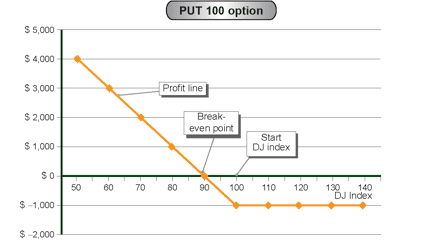| Market dATA | |
| DJ Index | 100 points |
| Prices | |
| Put 100 | $1,000 |
Strategy name:
Long Put option
Recommended use of strategy
Expectation of decline in DJ Index
Strategy components
Buying a Put option
Example: Long Put 100 at a price of $1,000
Expenses / Income from building the strategy (at start date)
Expenditure of $1,000
Strategy graph:

Auxiliary table for building the profit line
|
DJ Index (Horizontal axis) |
(Fixed expense) / fixed income |
Variable expenses |
Variable income (Put contribution) |
Total profit / (loss) (Vertical axis) 2+3+4 |
|
|
|
|
|
|
|
50 |
($1,000) |
– |
$5,000 |
$4,000 |
|
60 |
($1,000) |
– |
$4,000 |
$3,000 |
|
70 |
($1,000) |
– |
$3,000 |
$2,000 |
|
80 |
($1,000) |
– |
$2,000 |
$1,000 |
|
90 |
($1,000) |
– |
$1,000 |
$0 |
|
100 |
($1,000) |
– |
– |
($1,000) |
|
110 |
($1,000) |
– |
– |
($1,000) |
|
120 |
($1,000) |
– |
– |
($1,000) |
|
130 |
($1,000) |
– |
– |
($1,000) |
|
140 |
($1,000) |
– |
– |
($1,000) |
Source of profit
The profit arises from the Put option, when the DJ Index declines below the strike index (100 points). The profit increases as the index declines.
Source of loss
Cost of building the strategy – $1,000
Break-even point
The point where the losses from the Put option equal the cost of buying it at a price of $1,000. This occurs when the index is at 90 points.


